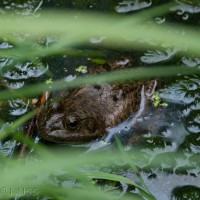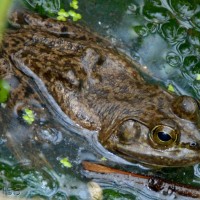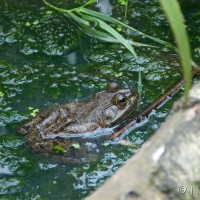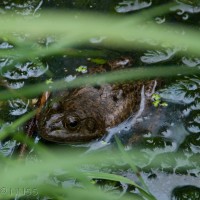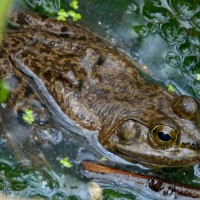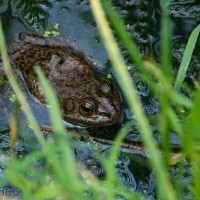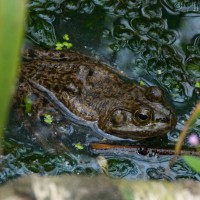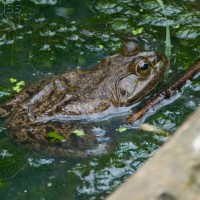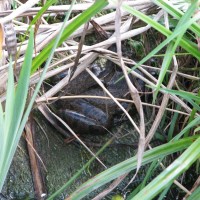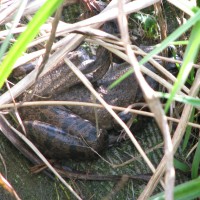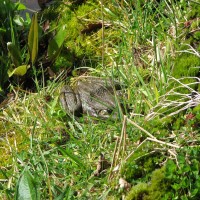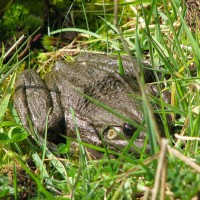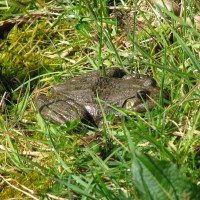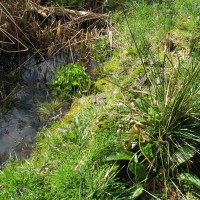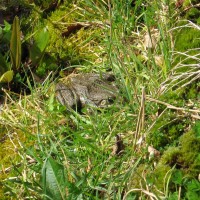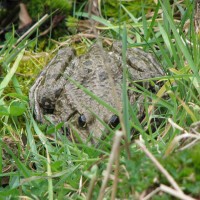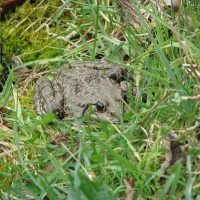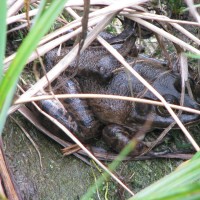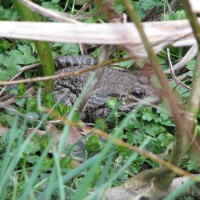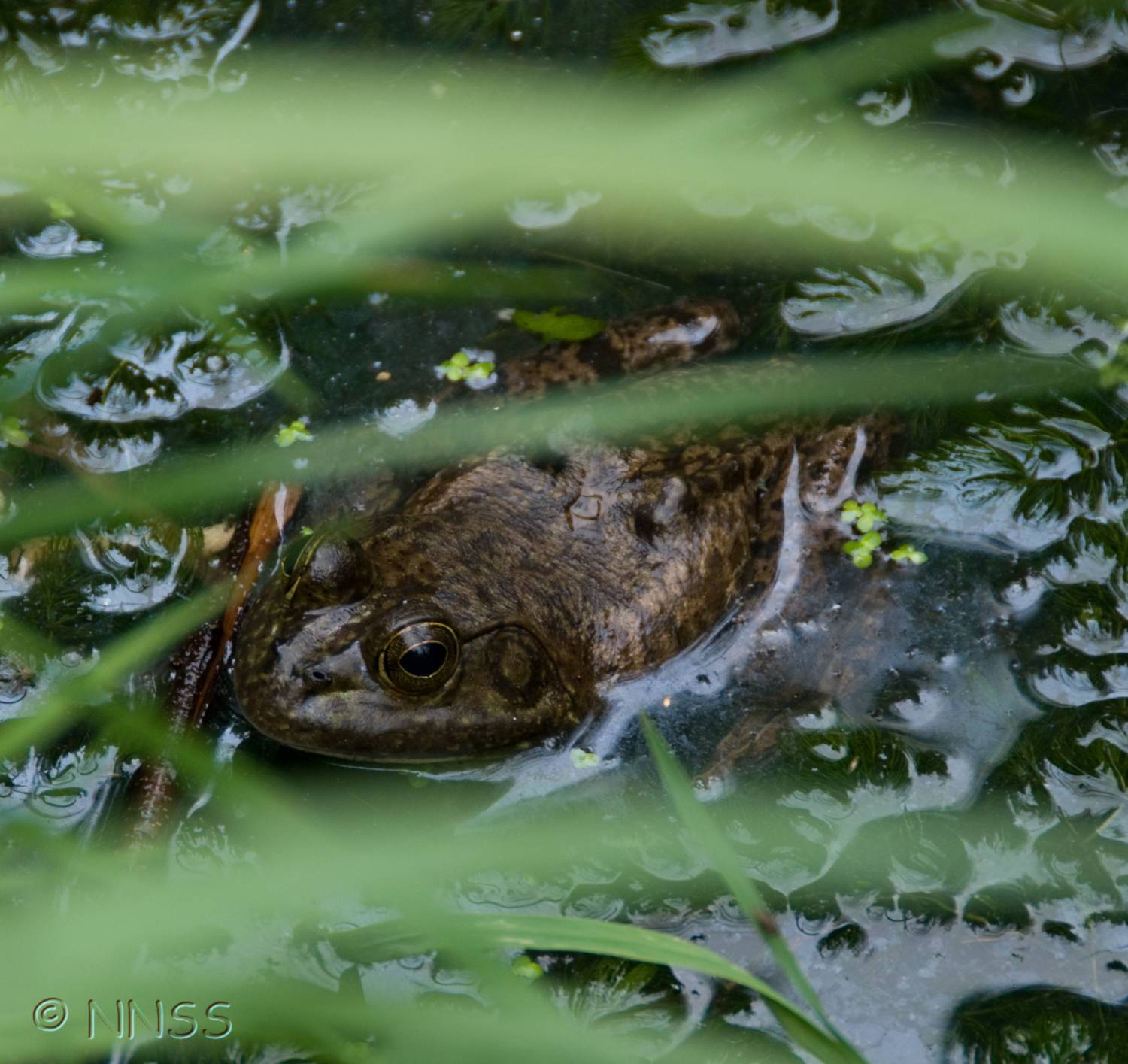
American Bullfrog - Lithobates catesbeianus
Expand and collapse the sections below by clicking on the title or + / - icons.
Short description of Lithobates catesbeianus, American Bullfrog
Bullfrogs are up to twice the length of the native common frog, and draw attention by their loud, deep calls. Their ear drum is obviously larger than the eye, with a conspicuous dark outer ring. The lack of skin folds along the back, and the single vocal sac positioned beneath the chin, help to distinguish this from other non-native frogs in GB. Tadpoles grow to up to 15 cm.
Impact summary: Lithobates catesbeianus, American Bullfrog
The bullfrog is one of the most harmful invasive non-native species. It both competes with and eats native amphibians, and carries a disease that has contributed to worldwide amphibian decline and to several global extinctions.
Habitat summary: Lithobates catesbeianus, American Bullfrog
It occupies any type of still or slowly moving water, especially where aquatic and bank vegetation are abundant, in the native range from sea level to 2000m. Calm water that will not dry out and deep pools in rivers and streams are preferred.
Overview table
| Environment | Terrestrial and Freshwater |
|---|---|
| Species status | Non-Native |
| Native range | Eastern United States, Far East United States |
| Functional type | Predator |
| Status in England | Non-Native |
| Status in Scotland | Non-Native |
| Status in Wales | Non-Native |
| Location of first record | Bexhill (14) |
| Date of first record | 1996 |
Origin
The bullfrog is native to eastern North America but has been introduced west of the Rockies and to around 25 countries worldwide during the past two centuries. At least 25 separate introduction attempts have been made in Europe.
First Record
The first single bullfrog in GB was found in East Sussex in 1996, and breeding was first noted at the same site in 1999.
Pathway and Method
Bullfrogs have been deliberately released as unwanted pets and have escaped from garden ponds where they had been confined as tadpoles. Others have been imported accidentally with fish stocks or aquatic plants. Introductions outside GB have also been made for biological control of insect pests and as stocking for human consumption.
Species Status
The initial population was successfully eradicated by 2004, after the removal of at least 9,000 animals. In 2006, a further breeding population was discovered in Essex: 100 animals were removed in 2007 but only five in 2008, suggesting that the population had already been greatly reduced. Presence, but not breeding, has been noted at a few further sites in SE England.
Dispersal Mechanisms
Natural dispersal is both terrestrial and via rivers, covering whole water catchments. Froglets cross arid country between ponds and are known to have travelled at least six miles in a few weeks.
Reproduction
In southwest France, the breeding period lasts from May until early September. Tadpole development takes 1–2 years; because of the long development period, pools that might dry out are generally avoided.
Known Predators/Herbivores
Predators include carnivorous fishes and probably some mustelids and herons. The main source of predation, in high-density areas, appears to be cannibalism. There are no known predators of adult bullfrogs in GB.
Resistant Stages
Bullfrogs hibernate underwater between October and March.
Habitat Occupied in GB
Bullfrogs might be found in GB in any freshwater pool or backwater that is unlikely to dry out.
Breeding populations discovered in East Sussex and Essex have been removed.
Environmental Impact
This species feeds day and night on a wide range of prey, including amphibians, fishes, small mammals, ducklings and small bird species, molluscs, crustaceans and insects. Both predation and competition may adversely affect populations of native frogs, toads and newts. American bullfrogs and other non-native amphibians may carry the chytrid fungus Batrachochytrium dendrobatidis, and can spread the disease chytridiomycosis to native amphibians.
Health and Social Impact
None known.
Economic Impact
The cost so far of control measures and monitoring in GB has been estimated to be more than £100 000.
Identification
NNSS ID Sheet - https://secure.fera.defra.gov.uk/nonnativespecies/index.cfm?sectionid=47
Biology, ecology, spread, vectors
Banks, B., Foster, J., Langton, T. & Morgan, K. (2000) British Bullfrogs? British Wildlife, 11, 327–330.
Stumpel, A.H.P. (1992) Successful reproduction of introduced bullfrogs Rana catesbeiana in northwestern Europe – a potential threat to indigenous amphibians. Biological Conservation, 60, 61–62.
Management and impact
Daszak, P., Strieby, A., Cunningham, A.A., Longcore, J.E., Brown, C.C. & Porter, D. (2004) Experimental evidence that the bullfrog (Rana catesbeiana) is a potential carrier of chytridiomycosis, an emerging fungal disease of amphibians. Herpetological Journal, 14, 201–207.
Fisher, M.C. & Garner, T.W.J. (2007) The relationship between the introduction of Batrachochytrium dendrobatidis, the international trade in amphibians and introduced amphibian species. Fungal Biology Reviews, 21, 2–9.
Garner, T.W.J., Perkins, M., Govindarajulu, P., Seglie, D., Walker, S.J., Cunningham, A.A. & Fisher, M.C. (2006) The emerging amphibian pathogen Batrachochytrium dendrobatidis globally infects introduced populations of the North American bullfrog, Rana catesbeiana. Biology Letters, 2, 455–459.
Lannoo, M. ( ed) (2005) Amphibian declines - the conservation status of United States species. University of California Press, Berkeley, CA.
General
Ficetola, G.F., Coïc, C., Detaint, M., Berroneau, M., Lorvelec, O. & Miaud, C. (2007) Pattern of distribution of the American bullfrog Rana catesbeiana in Europe. Biological Invasions, 9, 767–772.
Lever, C. (2009) The Naturalized Animals of Britain and Ireland. New Holland Publishers, London.
Spitzen – van der Sluijs, A.M. & Zollinger, R. (2010) Literature review on the American bullfrog Rana catesbeiana (Shaw, 1802). Stichting RAVON, Nijmegen, the Netherlands. full text
Alert status
American Bullfrog, Lithobates catesbeianus is an Alert Species
Find more information about this alert and the full list of alert species.
Spotted this species?
Distribution map
View the Distribution map for American Bullfrog, Lithobates catesbeianus from NBN Atlas

Native range map
View an interactive native range map for American Bullfrog, Lithobates catesbeianus
Risk assessment
Risk assessment for Rana catesbeiana. See a full list of non-native species Risk assessments.
Legislation
Lithobates catesbeianus is a Species of Special concern. Read more about Non-native species legislation.
Listen to American Bullfrog

